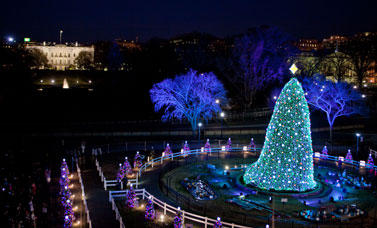During the holidays, trees in every community do double duty as harbingers of the season. In the town where I live, many street trees are ablaze with lights, transforming the shopping district into a cheerful and magical destination.

Here in Washington, our headquarters is only a few blocks from the National Christmas Tree, which President Obama and his family lit just last week. The tree, which is on the Ellipse just south of the White House, is visited by thousands of people from all over the country every year. We at American Forests have a special relationship with the tree, as it is a part of our history.
The first “Community Christmas Tree” was lit by President Calvin Coolidge on the Ellipse in 1923, but the president was concerned about the number of live trees that were being cut from forests for holiday decorations — this was, of course, before the advent of the Christmas tree farm. So, in 1924, the American Forestry Association (our name prior to 1990) donated the first live National Christmas Tree to President Coolidge and the American people and planted it on the Ellipse. Since then, the National Christmas Tree has played an important role in our nation’s celebration of the holiday season.
The tree was originally a balsam fir, but several tree species have had the honor since then, as over the years the trees have become damaged by weather and other factors. These include a Norway spruce, blue spruce, Fraser fir, red cedar, oriental spruce and Colorado blue spruce. The current National Christmas Tree is a 26.5-foot Colorado blue spruce that was planted last March after a severe storm felled the previous Colorado blue spruce that had served as the National Christmas Tree since 1978.
The National Park Service suggested replacing the live national tree with an artificial one in 1946, but that idea received significant opposition. From 1954 to 1972, the Park Service switched to a cut National Christmas Tree. Fortunately, a spontaneous, grassroots letter-writing campaign by American citizens began pressing for a live tree in 1965 and intensified by 1969. After a much larger letter-writing campaign in 1972, the National Park Service finally bowed to public pressure and planted a live tree again.
If you celebrate Christmas, chances are you have a tree of your own. While typically our work at American Forests involves protecting and restoring forests, there is absolutely nothing wrong with Christmas tree farms and real Christmas trees, which can have a number of environmental benefits in their own right. According to the National Christmas Tree Association:
- There are approximately 25-30 million real Christmas trees sold in the U.S. every year.
- There are close to 350 million real Christmas trees currently growing on Christmas tree farms, all planted by farmers, in the U.S. alone. These trees are planted and grown as a crop for the explicit reason of providing Christmas trees.
- There are more than 4,000 local Christmas tree recycling programs throughout the United States.
- For every real Christmas tree harvested, one to three seedlings are planted the following spring.
- There are about 350,000 acres in production for growing Christmas trees in the U.S., much of which is preserving green space.
No matter what holidays you may be celebrating during the weeks ahead, may your days be merry and bright. Happy holidays from all of us at American Forests!